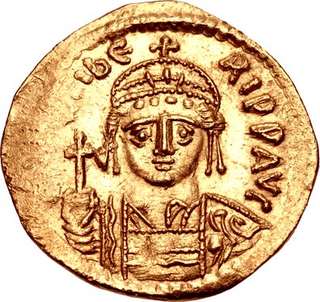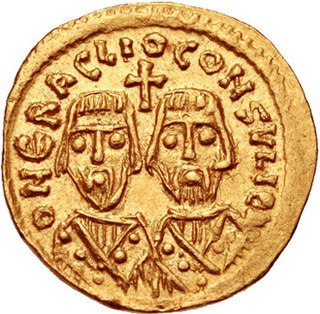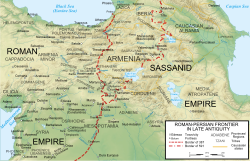
Maurice was Eastern Roman emperor from 582 to 602 and the last member of the Justinian dynasty. A successful general, Maurice was chosen as heir and son-in-law by his predecessor Tiberius II.

Hormizd IV was the Sasanian King of Kings of Iran from 579 to 590. He was the son and successor of Khosrow I and his mother was a Khazar princess.

The Battle of Solachon was fought in 586 CE in northern Mesopotamia between the East Roman (Byzantine) forces, led by Philippicus, and the Sassanid Persians under Kardarigan. The engagement was part of the long and inconclusive Byzantine–Sassanid War of 572–591. The Battle of Solachon ended in a major Byzantine victory which improved the Byzantine position in Mesopotamia, but it was not in the end decisive. The war dragged on until 591, when it ended with a negotiated settlement between Maurice and the Persian shah Khosrau II.
The Roman–Persian Wars, also known as the Roman–Iranian Wars, were a series of conflicts between states of the Greco-Roman world and two successive Iranian empires: the Parthian and the Sasanian. Battles between the Parthian Empire and the Roman Republic began in 54 BC; wars began under the late Republic, and continued through the Roman and Sasanian empires. A plethora of vassal kingdoms and allied nomadic nations in the form of buffer states and proxies also played a role. The wars were ended by the early Muslim conquests, which led to the fall of the Sasanian Empire and huge territorial losses for the Byzantine Empire, shortly after the end of the last war between them.

Bahrām Chōbīn or Wahrām Chōbēn, also known by his epithet Mehrbandak, was a nobleman, general, and political leader of the late Sasanian Empire and briefly its ruler as Bahram VI.

Heraclius the Elder was a Byzantine general and the father of Byzantine emperor Heraclius. Generally considered to be of Armenian origin Heraclius the Elder distinguished himself in the war against the Sassanid Persians in the 580s. As a subordinate general, Heraclius served under the command of Philippicus during the Battle of Solachon and possibly served under Comentiolus during the Battle of Sisarbanon. In circa 595, Heraclius the Elder is mentioned as a magister militum per Armeniam sent by Emperor Maurice to quell an Armenian rebellion led by Samuel Vahewuni and Atat Khorkhoruni. In circa 600, he was appointed as the Exarch of Africa and in 608, Heraclius the Elder rebelled with his son against the usurper Phocas. Using North Africa as a base, the younger Heraclius managed to overthrow Phocas, beginning the Heraclian dynasty, which would rule Byzantium for a century. Heraclius the Elder died soon after receiving news of his son's accession to the Byzantine throne.

The Byzantine–Sasanian War of 572–591 was a war fought between the Sasanian Empire of Persia and the Eastern Roman Empire, termed by modern historians as the Byzantine Empire. It was triggered by pro-Byzantine revolts in areas of the Caucasus under Persian hegemony, although other events also contributed to its outbreak. The fighting was largely confined to the southern Caucasus and Mesopotamia, although it also extended into eastern Anatolia, Syria, and northern Iran. It was part of an intense sequence of wars between these two empires which occupied the majority of the 6th and early 7th centuries. It was also the last of the many wars between them to follow a pattern in which fighting was largely confined to frontier provinces and neither side achieved any lasting occupation of enemy territory beyond this border zone. It preceded a much more wide-ranging and dramatic final conflict in the early 7th century.
Petrus (Greek: Πέτρος, Petros, also known as Peter in English was a brother of the Byzantine Emperor Maurice.
Maurice's Balkan campaigns were a series of military expeditions conducted by Roman Emperor Maurice in an attempt to defend the Balkan provinces of the Roman Empire from the Avars and the South Slavs. Maurice was the only East Roman emperor, other than Anastasius I, who did his best to implement determined Balkan policies during Late Antiquity by paying adequate attention to the safety of the northern frontier against barbarian incursions. During the second half of his reign, the Balkan campaigns were the main focus of Maurice's foreign policies, as a favourable peace treaty with Persian Empire in 591 enabled him to shift his experienced troops from the Persian front to the region. The refocusing of Roman efforts soon paid off: the frequent Roman failures before 591 were succeeded by a string of successes afterwards.
Comentiolus was a prominent Eastern Roman (Byzantine) general at the close of the 6th century during the reign of Emperor Maurice. He played a major role in Maurice's Balkan campaigns, and fought also in the East against the Sassanid Persians. Comentiolus was ultimately executed in 602 after the Byzantine army rebelled against Maurice and Emperor Phocas usurped the throne.
Philippicus or Philippikos was an East Roman general, comes excubitorum, and brother-in-law of Emperor Maurice. His successful career as a general spanned three decades, chiefly against the Sassanid Persians.
Priscus or Priskos was a leading Eastern Roman general during the reigns of the Byzantine emperors Maurice, Phocas and Heraclius. Priscus comes across as an effective and capable military leader, although the contemporary sources are markedly biased in his favour. Under Maurice, he distinguished himself in the campaigns against the Avars and their Slavic allies in the Balkans. Absent from the capital at the time of Maurice's overthrow and murder by Phocas, he was one of the few of Maurice's senior aides who were able to survive unharmed into the new regime, remaining in high office and even marrying the new emperor's daughter. Priscus, however, also negotiated with and assisted Heraclius in the overthrow of Phocas, and was entrusted with command against the Persians in 611–612. After the failure of this campaign, he was dismissed and tonsured. He died shortly after.
Germanus, called "patricius", was a leading member of the Byzantine Senate during the reign of Maurice.
Germanus was a Byzantine general who served under Emperor Phocas in the early stages of the Byzantine-Sassanid War of 602–628.

The Battle of the Blarathon, also known as the Battle of Ganzak, was fought in 591 near Ganzak between a combined Byzantine–Persian force and a Persian army led by the usurper Bahram Chobin.

Theodosius was the eldest son of Byzantine Emperor Maurice and was co-emperor from 590 until his deposition and execution during a military revolt. Along with his father-in-law Germanus, he was briefly proposed as successor to Maurice by the troops, but the army eventually favoured Phocas instead. Sent in an abortive mission to secure aid from Sassanid Persia by his father, Theodosius was captured and executed by Phocas's supporters a few days after Maurice. Nevertheless, rumours spread that he had survived the execution, and became popular to the extent that a man who purported to be Theodosius was entertained by the Persians as a pretext for launching a war against Byzantium.
Alexander was a Byzantine military officer, active in the reign of Maurice. He is styled a taxiarch in the accounts of Theophylact Simocatta. He is known for his part in campaigns against the South Slavs.

The Battles of Viminacium were a series of three battles fought against the Avars by the Eastern Roman Empire. They were decisive Roman successes, which were followed by an invasion of Pannonia.

The Avar–Byzantine wars were a series of conflicts between the Byzantine Empire and the Avar Khaganate. The conflicts were initiated in 568, after the Avars arrived in Pannonia, and claimed all the former land of the Gepids and Lombards as their own. This led to an unsuccessful attempt to seize the city of Sirmium from Byzantium, which had previously retaken it from the Gepids. Most subsequent conflicts came as a result of raids by the Avars, or their subject Slavs, into the Balkan provinces of the Byzantine Empire.
Mahbod, was a 6th-century Iranian ambassador and military officer from the House of Suren, who was active during the reign of the Sasanian shahanshahs Khosrow I and Hormizd IV.









